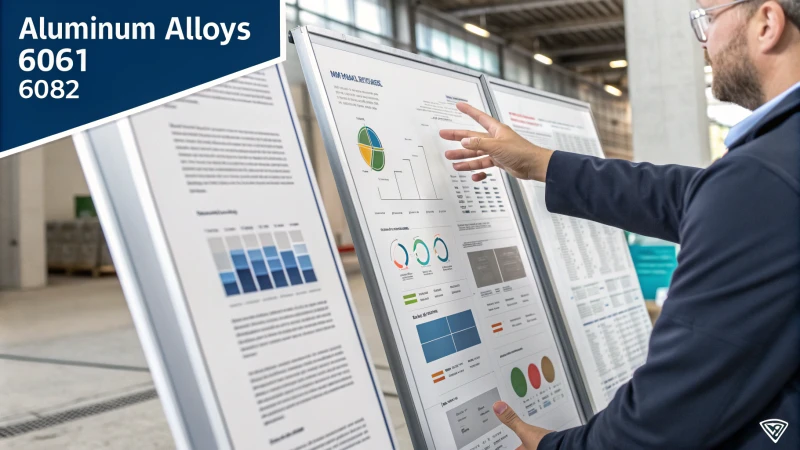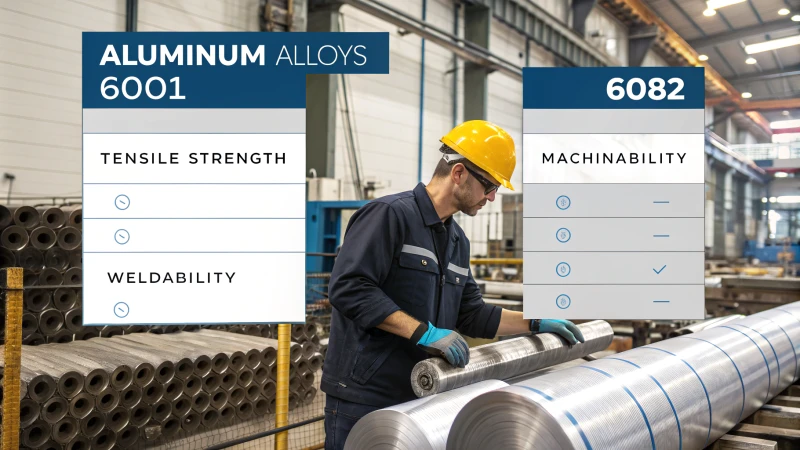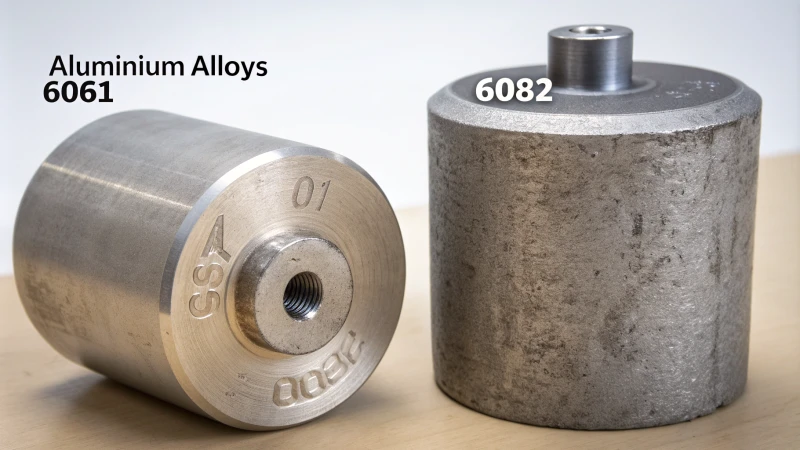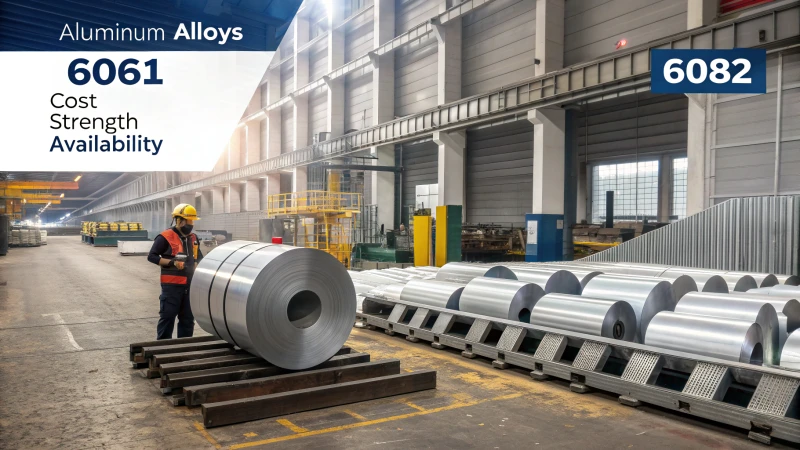What is the difference between 6061 and 6082?

Aluminum alloys are integral to various industries, but selecting the right one can be challenging. Let’s explore the key differences between 6061 and 6082 alloys.
The primary difference between 6061 and 6082 aluminum alloys lies in their composition, strength, and applications. While both belong to the 6000 series, 6061 is known for its versatility and ease of fabrication, whereas 6082 offers higher strength and is ideal for load-bearing structures.
As we delve deeper into the nuances of these two alloys, you will discover valuable insights that can help you choose the perfect material for your projects.
What are the specific applications of 6061 and 6082 alloys?
Understanding the specific applications of aluminium alloys 6061 and 6082 is crucial for selecting the right material for your project. Let’s explore their unique uses across various industries.
6061 alloy is widely used in aerospace and automotive applications due to its good balance of strength and workability. In contrast, 6082 excels in structural applications requiring higher strength, such as bridges and heavy-duty machinery.

Overview of 6061 Alloy Applications
6061 aluminium alloy is renowned for its versatility, making it suitable for a wide range of applications across various industries. Its medium strength, good corrosion resistance, and ease of fabrication are key factors that contribute to its popularity.
-
Aerospace Industry: Used in aircraft components due to its lightweight nature and structural integrity. For instance, the alloy is often found in aircraft frames.
-
Marine Applications: Its corrosion resistance makes it ideal for boat hulls and other marine structures, where exposure to saltwater is common. An example includes marine fittings.
-
Automotive Industry: Frequently used in manufacturing parts like chassis and frames, providing strength without adding excessive weight. Components such as car body panels leverage its properties effectively.
Overview of 6082 Alloy Applications
On the other hand, 6082 alloy is recognized for its higher strength and is often chosen for more demanding applications where load-bearing capacity is crucial.
-
Bridge Construction: The strength of 6082 makes it suitable for bridge structures where it can withstand heavy loads and dynamic forces. Structural elements in bridge design benefit from its capabilities.
-
Transport Industry: Utilized in manufacturing truck bodies and trailers due to its durability and strength, allowing it to endure heavy usage over time. For example, trailer frames made from this alloy are common.
-
Heavy-Duty Structural Applications: Commonly found in industrial settings where high strength is a must, such as in construction machinery and structural supports.
Comparison Table of Applications
| Alloy Type | Application Category | Specific Use Cases | Strength Characteristics |
|---|---|---|---|
| 6061 | Aerospace | Aircraft frames | Medium strength, easy to fabricate |
| Marine | Boat hulls | Good corrosion resistance | |
| Automotive | Chassis, body panels | Versatile and lightweight | |
| 6082 | Bridge Construction | Structural elements | Higher strength, suitable for heavy loads |
| Transport | Truck bodies, trailers | Superior load-bearing capacity | |
| Heavy-Duty Structures | Construction machinery | Excellent strength-to-weight ratio |
Final Insights on Choosing the Right Alloy
When deciding between 6061 and 6082 alloys, consider the specific requirements of your project. If your project emphasizes workability and general use, 6061 may be the better choice. However, if you need superior strength for structural applications, 6082 should be your go-to material.
How do the mechanical properties of 6061 and 6082 compare?
Comparing the mechanical properties of aluminum alloys 6061 and 6082 reveals important differences that impact their applications. Let’s dive into their characteristics.
The mechanical properties of 6061 and 6082 differ significantly. 6082 offers higher strength and tensile properties than 6061, making it suitable for demanding structural applications. However, 6061 is easier to machine and weld, making it versatile for general use.

Understanding the Basics of 6061 and 6082
Both 6061 and 6082 are part of the 6000-series aluminium alloys, which are primarily used in structural applications. The distinct differences in their mechanical properties arise from their chemical compositions.
- 6061: Known for its versatility, it contains magnesium and silicon, making it suitable for general fabrication.
- 6082: Offers higher strength due to increased magnesium and silicon content, making it ideal for applications that require robust materials.
Mechanical Properties Comparison
| Property | 6061 T6 | 6082 T6 |
|---|---|---|
| Yield Strength | 40,000 psi (275 MPa) | 45,000 psi (310 MPa) |
| Ultimate Tensile Strength | 45,000 psi (310 MPa) | 50,000 psi (345 MPa) |
| Elongation | 12% | 10% |
| Hardness (Brinell) | 95 | 105 |
This table clearly shows that 6082 generally provides higher strength characteristics than 6061, particularly in the T6 temper. For projects needing high load-bearing capabilities, 6082 is often the preferred choice.
Corrosion Resistance
Both alloys exhibit good corrosion resistance but have subtle differences:
- 6061: Slightly better suited for marine environments due to its lower silicon content, which enhances its resistance to pitting.
- 6082: While still corrosion-resistant, it may not perform as well in saline conditions compared to 6061. This distinction is crucial when considering applications in coastal areas or marine settings.
Workability and Fabrication
When evaluating the workability of these alloys:
- 6061: Highly favored for machining, welding, and general fabrication. Its ease of handling makes it popular in various industries, including aerospace and automotive.
- 6082: Although it is less common for welding, it still provides good workability. Its high strength-to-weight ratio is vital in structural applications where weight savings are critical.
Applications Based on Mechanical Properties
Understanding the mechanical properties aids in selecting the right alloy for specific applications:
- 6061: Typically used in structural components, piping, frames, and marine applications due to its balance of strength and workability.
- 6082: Often found in heavy-duty structural applications such as bridge construction and transport industries where enhanced strength is paramount.
For more insights into the applications of these alloys, check out this article.
Final Thoughts on Mechanical Comparisons
When choosing between these two alloys, consider your specific application needs. If strength is your main concern, lean towards 6082. However, if ease of fabrication is your priority, 6061 may be your best bet. For a deeper understanding of these properties, explore this resource.
What factors influence the corrosion resistance of these alloys?
Corrosion resistance in aluminium alloys is influenced by several factors including chemical composition, environmental conditions, surface treatments, mechanical properties, and maintenance practices.
The corrosion resistance of aluminium alloys such as 6061 and 6082 is influenced by their chemical composition, environmental exposure, surface treatments, mechanical properties, and ongoing maintenance practices.

1. Chemical Composition
The chemical makeup of alloys plays a pivotal role in their corrosion resistance.
For example, higher silicon content in alloys like 6082 can lead to more susceptibility to corrosion in certain environments.
The specific alloying elements like magnesium and copper also influence how the material reacts to oxidizing environments.
- 6061: Contains 0.4–0.8% silicon, offering better resistance in marine applications due to lower silicon content compared to 6082.
- 6082: Has a higher silicon content (0.7–1.3%) which, while enhancing strength, may reduce its corrosion resistance in specific conditions.
A detailed understanding of these elements can guide manufacturers in selecting the right alloy for their needs, particularly in harsh environments.
2. Environmental Conditions
The environment in which an alloy is used significantly affects its corrosion behavior.
Factors such as humidity, temperature, and exposure to saltwater or acidic conditions can accelerate corrosion processes.
- Marine Environments: Alloys like 6061 demonstrate superior performance against corrosion due to their unique chemical properties.
- Industrial Settings: Exposure to chemicals or pollutants can affect the integrity of the alloy, necessitating further protective measures.
Understanding the specific environmental challenges is crucial for selecting the right alloy type. For instance, coatings or anodizing can enhance protection against these variables.
3. Surface Treatment
| The application of surface treatments can drastically improve an alloy’s resistance to corrosion. Processes such as anodizing, painting, or applying protective coatings can create a barrier against environmental factors. | Treatment Type | Description | Benefits |
|---|---|---|---|
| Anodizing | Electrolytic process that converts the surface into a durable oxide layer. | Enhances corrosion resistance and aesthetic appeal. | |
| Powder Coating | Applying a dry powder that is cured under heat to form a hard finish. | Provides a protective layer that is resistant to chemicals and scratches. |
These treatments are particularly important for alloys used in outdoor or corrosive environments, ensuring longevity and durability of products made from these materials.
4. Mechanical Properties
The mechanical properties of an alloy, including its strength and ductility, can also impact its corrosion resistance.
Stronger alloys like 6082 may exhibit different corrosion behavior compared to more ductile alloys like 6061.
- Yield Strength: Higher strength materials may suffer from stress corrosion cracking in certain environments.
- Ductility: More ductile alloys can better absorb environmental stresses, potentially enhancing their lifespan.
Understanding these mechanical properties is essential when designing components that will be exposed to corrosive environments.
5. Protective Measures and Maintenance
Routine maintenance and protective measures play a crucial role in prolonging the lifespan of aluminum alloys against corrosion.
- Regular inspections can help identify early signs of corrosion.
- Applying protective coatings periodically can renew the protective layer on the alloy surfaces.
Understanding the best practices for maintenance can significantly influence the overall performance and longevity of these materials in various applications.
In what scenarios should you choose 6061 over 6082 and vice versa?
When deciding between aluminium alloys 6061 and 6082, understanding their specific properties is crucial. This guide explores the scenarios where each alloy excels.
Choosing between 6061 and 6082 aluminium alloys depends on your specific project needs. Use 6061 for general fabrication and corrosion resistance; choose 6082 for strength and durability in demanding applications.

Understanding the Differences
Choosing between 6061 and 6082 aluminium alloys ultimately depends on your project’s specific requirements. Here’s a deeper dive into their characteristics:
| Feature | 6061 | 6082 |
|---|---|---|
| Yield Strength | ~40,000 psi (275 MPa) | ~45,000 psi (310 MPa) |
| Tensile Strength | ~45,000 psi (310 MPa) | Up to ~50,000 psi (345 MPa) |
| Corrosion Resistance | Slightly better in marine environments | Good, but lower than 6061 |
| Workability | Easier to machine and weld | More challenging for welding |
Scenarios for Choosing 6061
- General Fabrication: If your project requires versatile material that is easy to machine, 6061 is the go-to option. It’s widely used in construction and marine applications.
- Corrosion Resistance: For projects in marine environments where corrosion is a concern, 6061 offers slightly better protection, making it a reliable choice.
- Cost Considerations: Generally, 6061 is more cost-effective, which is a significant factor for projects with budget constraints.
Scenarios for Choosing 6082
- High-Strength Applications: If your project demands greater strength, particularly under load-bearing conditions like bridge construction or heavy-duty structures, 6082 is the better choice.
- Durability Needs: When durability is paramount and the design can afford a little more complexity in fabrication, opt for 6082 due to its superior strength-to-weight ratio.
- Specific Structural Requirements: In scenarios where high mechanical performance is needed, such as in transport industries, 6082 proves advantageous.
Summary of Considerations
- If you prioritize ease of fabrication and corrosion resistance, go with 6061.
- For projects needing enhanced strength and durability, especially in demanding environments, choose 6082.
For further insights on material selection and comparisons, feel free to explore comparing aluminium alloys.
How does the cost of 6061 compare to 6082 in manufacturing?
Understanding the cost differences between aluminium alloys 6061 and 6082 is crucial for manufacturers seeking optimal material selection for their projects.
The cost of 6061 is generally lower than that of 6082 due to its wider availability and easier fabrication processes, though specific project requirements may justify the higher cost of 6082 for its superior strength.

Understanding the Cost Factors in Aluminium Manufacturing
When comparing the costs of 6061 and 6082 aluminium alloys, several factors come into play. These include raw material costs, processing costs, and market demand. Let’s break these down further.
1. Raw Material Costs
The cost of raw aluminium can fluctuate based on global market trends. Generally, both alloys are sourced from similar markets, but the specific compositions lead to slight variations in price.
- 6061 typically has a lower price due to its widespread availability and versatility.
- 6082, being stronger and having higher magnesium and silicon content, might command a premium price.
2. Processing and Fabrication Costs
| Processing costs can also vary significantly between the two alloys: | Factor | 6061 | 6082 |
|---|---|---|---|
| Ease of Machining | Easier to machine | Moderate difficulty | |
| Welding Capability | Excellent | Moderate | |
| Formability | High | Moderate |
Because 6061 is easier to machine and weld, it often results in lower fabrication costs. However, if the project requires higher strength, the additional cost of using 6082 could be justified.
3. Market Demand and Application
The demand for each alloy can influence their costs significantly. For example, 6061 is widely used in various applications such as:
- Structural components
- Marine applications
- Aerospace industry
On the other hand, 6082 is preferred for applications needing higher strength like:
- Bridge construction
- Heavy-duty structures
- Transport industries
This demand can affect pricing strategies and availability in the market.
4. Long-term Cost Implications
While upfront costs are important, considering long-term implications is also crucial. 6061 may offer lower initial costs but might not withstand heavy loads as effectively as 6082, leading to potential future costs in repairs or replacements. Therefore, assessing the total cost of ownership could provide a clearer financial picture.
For further insights into aluminium alloy pricing trends, check out this resource.
Conclusion
When deciding between 6061 and 6082, it’s essential to weigh both initial and long-term costs against the specific needs of your project. Understanding these nuances can significantly impact your procurement strategy and overall project budget.
Conclusion
Explore key differences between aluminum alloys 6061 and 6082 in terms of composition, strength, applications, and corrosion resistance to make informed material choices.



